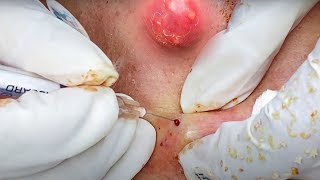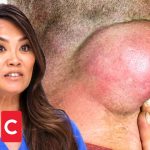If you’re dealing with big cystic acne or blackheads, here’s how to handle them safely and effectively, depending on whether they’re inflamed cysts or stubborn clogged pores.
🔍 First, What’s the Difference?
-
Cystic Acne: Large, painful, red lumps deep under the skin. Filled with pus. Can scar.
-
Blackheads: Open clogged pores filled with oil and dead skin. Not usually painful.
🔴 For Big Cystic Acne:
These require medical treatment. Do NOT squeeze—it worsens inflammation and causes scarring.
✅ What You Can Do:
-
Apply a warm compress (10–15 minutes, twice daily) – reduces swelling and helps drainage.
-
Use over-the-counter products with:
-
Benzoyl peroxide (kills bacteria, reduces inflammation)
-
Salicylic acid (clears pores)
-
-
Avoid touching or squeezing – this can push infection deeper.
-
Ice packs – help reduce pain and inflammation.
🩺 Medical Treatments:
-
Prescription creams (topical retinoids, antibiotics)
-
Oral antibiotics (e.g., doxycycline, minocycline)
-
Hormonal treatment (e.g., birth control pills, spironolactone)
-
Isotretinoin (Accutane) – for severe, resistant cystic acne
-
Corticosteroid injections – for quick relief of individual cysts
⚫ For Large Blackheads:
These can be managed at home or professionally removed.
✅ What You Can Do:
-
Salicylic acid cleanser – gently exfoliates and clears pores.
-
Retinoids (adapalene, tretinoin) – prevent clogged pores and help clear blackheads.
-
Clay masks or charcoal masks – absorb oil and debris.
-
Don’t squeeze with fingers – causes trauma and can worsen the situation.
🧼 Professional Help:
-
Dermatologist extraction using sterile tools
-
Chemical peels to exfoliate and renew skin
-
Microdermabrasion or laser treatments
🧴 Prevention Tips for Both:
-
Wash face twice daily with a gentle cleanser
-
Use non-comedogenic (won’t clog pores) skincare and makeup
-
Avoid heavy oils or greasy products
-
Change pillowcases regularly
-
Don’t sleep with makeup on
🧬 Understanding Cystic Acne
Cystic acne is a severe form of acne characterized by large, painful, pus-filled cysts beneath the skin’s surface. It’s often resistant to over-the-counter treatments and can lead to scarring if not properly managed.
Causes:
-
Hormonal fluctuations: Particularly during puberty, menstruation, or pregnancy.
-
Excess sebum production: Overactive sebaceous glands.
-
Bacterial overgrowth: Specifically Cutibacterium acnes.
-
Genetic predisposition: Family history of acne.
🩺 Evidence-Based Treatments for Cystic Acne
1. Topical Retinoids
-
Mechanism: Normalize skin cell turnover, preventing clogged pores.
-
Options: Adapalene (Differin), Tretinoin.
-
Usage: Apply once daily, preferably at night. Start with a lower concentration to minimize irritation.
-
Note: May cause initial dryness or peeling; this typically subsides with continued use.
2. Oral Antibiotics
-
Purpose: Reduce C. acnes bacteria and inflammation.
-
Common Medications: Doxycycline, Minocycline.
-
Considerations: Long-term use may lead to antibiotic resistance; typically prescribed for short durations.
3. Oral Isotretinoin (Accutane)
-
Indication: Severe, nodulocystic acne unresponsive to other treatments.
-
Mechanism: Decreases sebum production, shrinks sebaceous glands, and has anti-inflammatory effects.
-
Monitoring: Requires regular blood tests due to potential side effects like liver toxicity and hyperlipidemia.
-
Effectiveness: Approximately 85% of users experience significant improvement within 4–6 months .
4. Hormonal Therapies
-
Spironolactone: An anti-androgen medication effective in reducing sebum production, particularly in females with hormonal acne.
-
Oral Contraceptives: Certain birth control pills can regulate hormones and reduce acne flare-ups in women .
5. Corticosteroid Injections
-
Use: Directly injected into large cysts to reduce inflammation and promote rapid healing.
-
Procedure: Typically performed by a dermatologist.
⚫ Managing Blackheads
Blackheads are open comedones formed when hair follicles become clogged with oil and dead skin cells, oxidizing and turning black upon exposure to air.
At-Home Treatments:
-
Salicylic Acid: A beta-hydroxy acid that penetrates pores to exfoliate and reduce oil buildup.
-
Retinoids: Help prevent clogged pores and promote cell turnover.
-
Clay Masks: Absorb excess oil and impurities from the skin.
-
Avoid: Squeezing or picking at blackheads, as this can lead to inflammation and scarring .
Professional Treatments:
-
Comedone Extraction: Performed by dermatologists to safely remove blackheads.
-
Chemical Peels: Use of acids like glycolic or salicylic acid to exfoliate the skin.
-
Microdermabrasion: A mechanical exfoliation technique to remove dead skin cells.
-
Laser Therapy: Targets sebaceous glands to reduce oil production .
🚫 Common Mistakes to Avoid
-
Squeezing or Picking: Increases risk of scarring and infection.
-
Over-Exfoliating: Can irritate the skin and worsen acne.
-
Inconsistent Use of Medications: Skipping treatments can hinder progress.
-
Using Non-Comedogenic Products: Ensure skincare and makeup products don’t clog pores.
🧴 Recommended Products
-
Salicylic Acid Cleanser: Helps unclog pores and reduce oil.
-
Benzoyl Peroxide Gel: Targets acne-causing bacteria.
-
Non-Comedogenic Moisturizer: Hydrates without clogging pores.
-
Oil-Free Sunscreen: Protects skin without contributing to acne.


